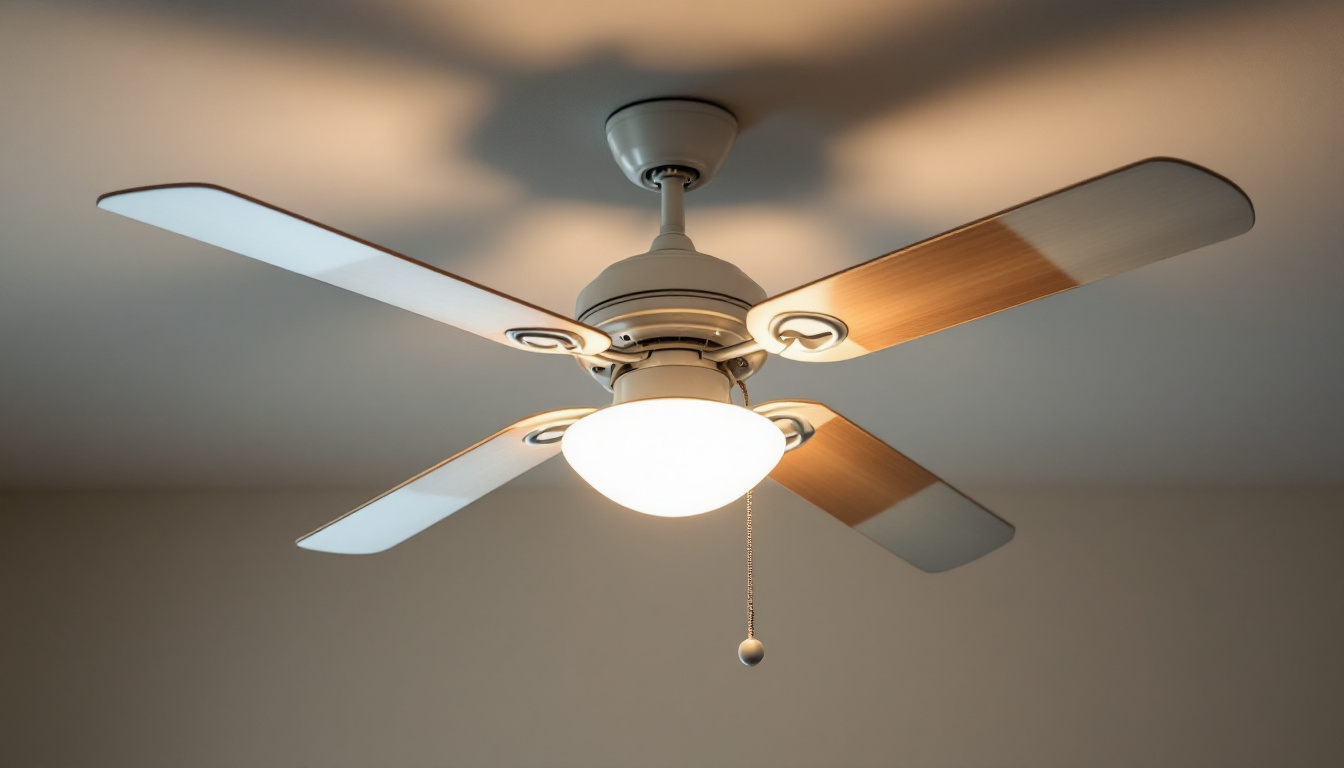
Ceiling fans are a staple in many homes and commercial spaces, providing comfort and style while also helping to reduce energy costs. For lighting contractors, understanding the various parts of a ceiling fan is essential for installation, maintenance, and troubleshooting. This article delves into the key components of ceiling fans, their functions, and important considerations for contractors.
At first glance, a ceiling fan may seem like a simple appliance, but it is composed of several intricate parts that work together to create airflow and enhance the aesthetics of a room. Familiarity with these components is crucial for lighting contractors who aim to provide exceptional service to their clients.
The motor is the heart of the ceiling fan, responsible for driving the blades and creating airflow. Typically, ceiling fans use either an AC (alternating current) motor or a DC (direct current) motor. AC motors are more common and generally less expensive, while DC motors are known for their energy efficiency and quieter operation.
When selecting a ceiling fan, contractors should consider the motor’s power and efficiency ratings. A higher wattage motor may provide stronger airflow but could also lead to increased energy consumption. Understanding the specifications of different motors can help contractors recommend the best options for their clients’ needs. Additionally, many modern ceiling fans come equipped with features such as remote controls and smart technology, allowing users to adjust settings conveniently. This integration of technology not only enhances user experience but also opens up opportunities for contractors to offer advanced solutions tailored to their clients’ preferences.
The blades of a ceiling fan play a significant role in determining the fan’s efficiency and airflow. Typically made from materials such as wood, plastic, or metal, the design and angle of the blades can significantly impact performance. Blades are usually pitched between 12 and 15 degrees for optimal airflow.
Contractors should also consider the number of blades when advising clients. While more blades can create a more aesthetic appeal, they may not necessarily provide better airflow compared to fans with fewer blades. The balance between aesthetics and functionality is key in selecting the right ceiling fan for a space. Furthermore, blade length and width can also influence airflow; longer blades can move more air, making them ideal for larger rooms, while shorter blades may be more suitable for compact spaces. Understanding the dynamics of blade design allows contractors to make informed recommendations that cater to both the practical and stylistic needs of their clients.
Blade arms, also known as blade brackets, connect the blades to the motor housing. They play a critical role in ensuring that the blades are securely attached and can rotate freely. The design and material of the blade arms can affect both the fan’s performance and its visual appeal.
When installing a ceiling fan, it is essential to ensure that the blade arms are properly aligned and tightened. Loose or misaligned blade arms can lead to wobbling, which not only affects performance but can also create noise and potential safety hazards. Additionally, blade arms come in various designs, from sleek and modern to ornate and traditional, allowing contractors to match the fan to the overall decor of the room. This attention to detail can significantly enhance the final look of the installation, making it not just a functional appliance but also a stylish addition to the space.
Beyond the motor and blades, several other components contribute to the overall functionality and aesthetics of ceiling fans. Understanding these parts can help lighting contractors provide better service and recommendations to their clients.
The canopy is the decorative cover that conceals the mounting hardware and wiring, providing a finished look to the ceiling fan installation. It is important for contractors to select a canopy that matches the fan’s design and color scheme to ensure a cohesive appearance.
Additionally, the canopy must be securely mounted to the ceiling to support the weight of the fan. proper installation is crucial to prevent any accidents or damage to the fan over time. Contractors should also check for any gaps between the canopy and the ceiling, which can lead to a less polished appearance and potential airflow issues.
Many ceiling fans come equipped with a pull chain or remote control for easy operation. The pull chain allows users to control the fan’s speed and lighting, while remote controls offer added convenience, especially for fans installed in high ceilings or hard-to-reach areas.
When installing a ceiling fan, contractors should ensure that the pull chain or remote control is functioning properly. Additionally, they should educate clients on how to use these controls effectively, including any special features the fan may have, such as reverse functionality for seasonal use.
Many ceiling fans are designed with an integrated light kit, allowing for both lighting and airflow in one unit. Light kits can vary significantly in design, from simple bulbs to elaborate fixtures that enhance the fan’s aesthetic appeal.
Contractors should be aware of the different types of bulbs compatible with the light kit, including incandescent, LED, and CFL options. Each type has its own benefits and drawbacks in terms of energy efficiency, brightness, and longevity. Properly advising clients on the best lighting options can enhance their overall satisfaction with the ceiling fan installation.
Proper installation is crucial for the optimal performance of a ceiling fan. Lighting contractors must be diligent in following manufacturer guidelines and local building codes to ensure safety and efficiency.
Ceiling fans can be mounted in various ways, depending on the height of the ceiling and the design of the fan. Standard mounts are suitable for standard ceiling heights, while downrods may be necessary for higher ceilings. Flush mounts are ideal for low ceilings, providing a sleek look without sacrificing airflow.
Contractors should assess the installation site carefully to determine the best mounting option. Incorrect mounting can lead to poor performance, increased noise, and potential safety hazards. Additionally, ensuring that the fan is level is critical for optimal airflow and aesthetics.
Electrical wiring is a vital aspect of ceiling fan installation. Contractors must ensure that the existing wiring is compatible with the fan’s motor and light kit. This includes checking for sufficient amperage and ensuring that the circuit can handle the load.
It is also essential to follow all safety protocols when working with electrical wiring. Ensuring that the power is turned off at the circuit breaker before installation is a critical step in preventing accidents. Additionally, using the appropriate wire connectors and securing all connections will help ensure a safe and reliable installation.
Once the ceiling fan is installed, balancing it is essential to prevent wobbling and noise during operation. Most ceiling fans come with balancing kits that include weights to help achieve proper balance. Contractors should take the time to test the fan’s operation and make any necessary adjustments before completing the installation.
A well-balanced fan not only operates more efficiently but also enhances the overall user experience. Clients will appreciate a ceiling fan that runs smoothly and quietly, contributing to their satisfaction with the installation.
Regular maintenance is key to ensuring the longevity and performance of ceiling fans. Lighting contractors should educate clients on proper care and common troubleshooting tips to help them keep their fans in optimal condition.
Dust and debris can accumulate on the blades and motor over time, affecting airflow and efficiency. Contractors should recommend that clients clean their ceiling fans regularly, ideally every few months. Using a soft cloth or a duster can help remove dust without damaging the blades.
In addition to cleaning the blades, it is also important to check the motor and other components for any signs of wear or damage. Promptly addressing any issues can prevent more significant problems down the line.
Despite their durability, ceiling fans can experience common issues that may require troubleshooting. Some of these issues include wobbling, noise, or failure to operate. Lighting contractors should be prepared to address these concerns and provide clients with solutions.
For wobbling fans, checking the blade alignment and ensuring that all screws are tightened can often resolve the issue. Noise may be attributed to loose components or a lack of lubrication, while a fan that won’t operate could indicate electrical issues or a faulty motor.
While many ceiling fan issues can be resolved with simple troubleshooting, there are times when professional assistance is necessary. If a client experiences persistent problems or if the fan is not functioning correctly after installation, it may be time to call in a professional.
Contractors should emphasize the importance of seeking help for complex electrical issues or if the fan requires extensive repairs. Providing clients with reliable resources for professional assistance can enhance their overall experience and satisfaction.
Understanding the various parts of a ceiling fan is essential for lighting contractors who aim to provide top-notch service. From the motor and blades to the light kit and mounting options, each component plays a crucial role in the fan’s performance and aesthetics.
By familiarizing themselves with these parts and their functions, contractors can ensure proper installation, maintenance, and troubleshooting, ultimately leading to satisfied clients. As ceiling fans continue to be a popular choice for both comfort and style, having a comprehensive knowledge of their components will set contractors apart in a competitive market.
Ready to elevate your lighting projects with the finest ceiling fan parts? Look no further than LumenWholesale, where we provide contractors with exceptional, spec-grade lighting products at unbeatable wholesale prices. Our selection of ceiling fan components is designed to meet the highest industry standards, ensuring you deliver reliable and high-performance solutions to your clients. Take advantage of our hassle-free bulk buying options, complete with free shipping, and secure premium lighting without hidden fees or compromises. For quality, affordability, and convenience that outshines the rest, choose Wholesale Lighting at the Best Value with LumenWholesale.

Discover essential tips for selecting and installing garden solar lights to enhance your outdoor space without breaking the bank.

Explore the essential considerations for lighting contractors when installing under-cabinet lights.

Discover how drop lights for kitchen islands are revolutionizing the lighting industry.

Discover the essential best practices for LED fixtures tailored specifically for lighting contractors.